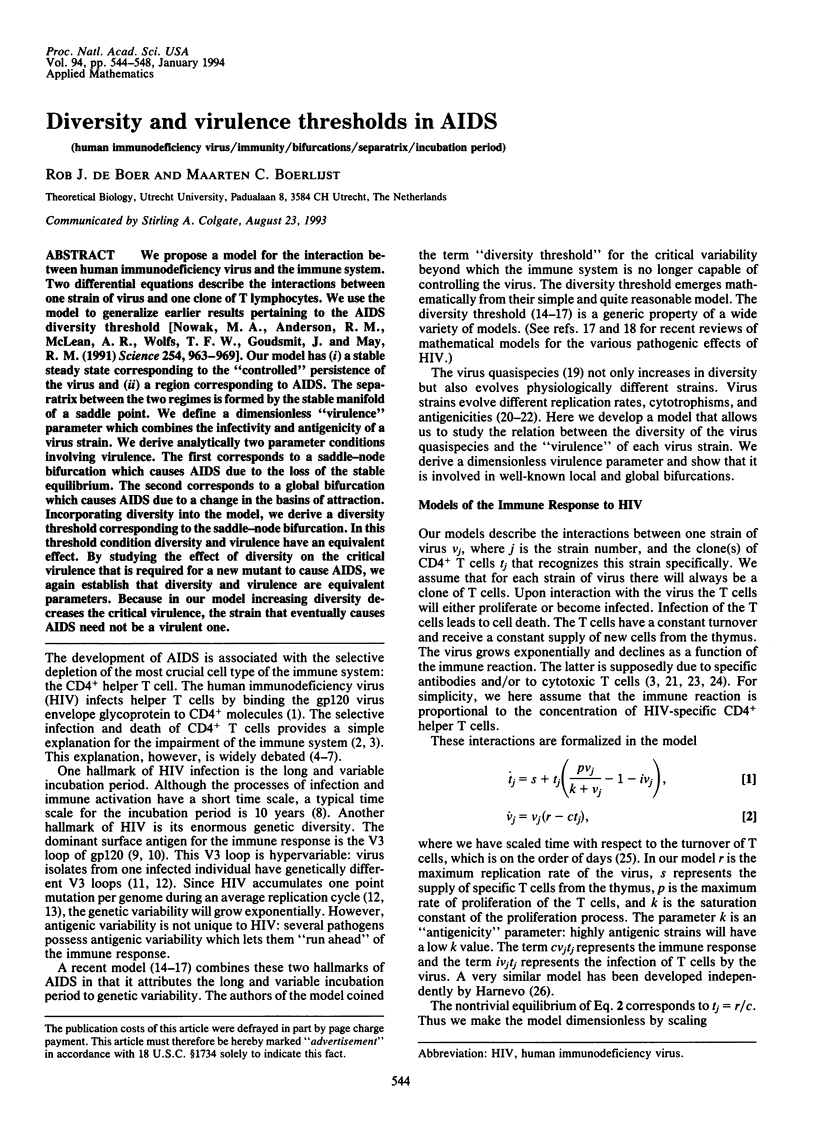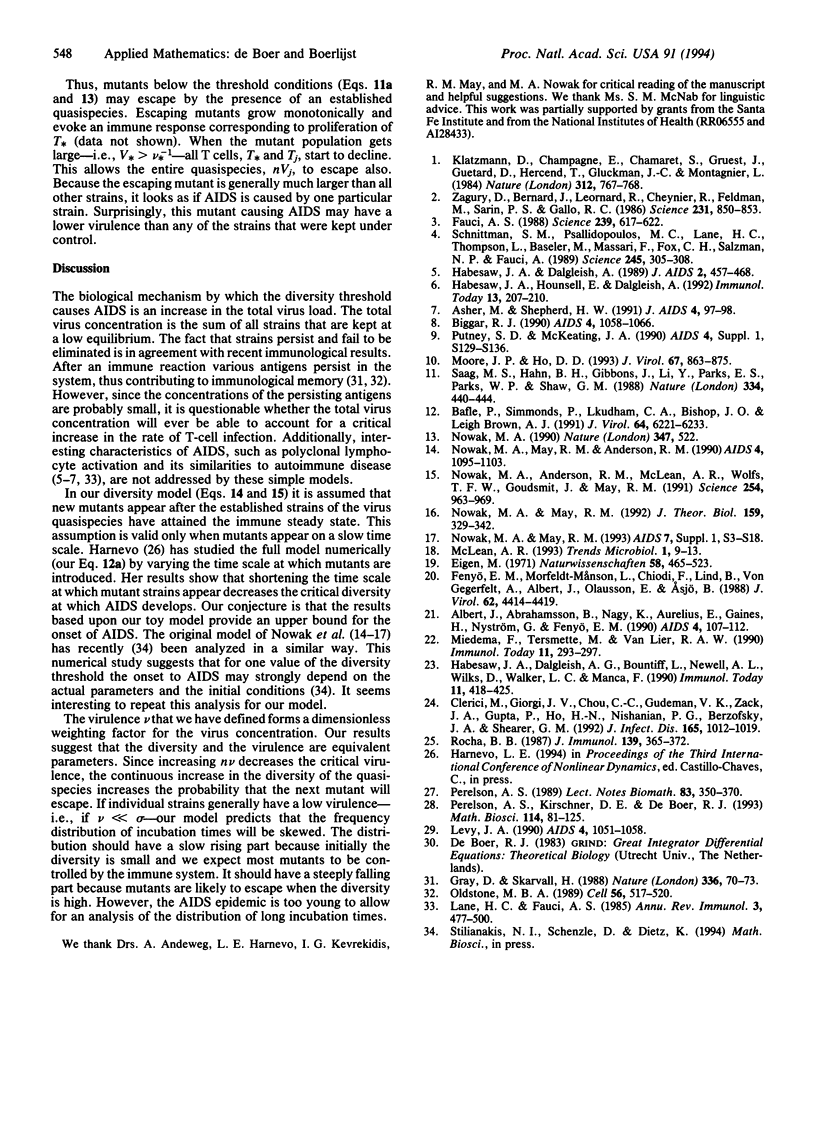Abstract
We propose a model for the interaction between human immunodeficiency virus and the immune system. Two differential equations describe the interactions between one strain of virus and one clone of T lymphocytes. We use the model to generalize earlier results pertaining to the AIDS diversity threshold [Nowak, M. A., Anderson, R. M., McLean, A. R., Wolfs, T. F. W., Goudsmit, J. and May, R. M. (1991) Science 254, 963-969]. Our model has (i) a stable steady state corresponding to the "controlled" persistence of the virus and (ii) a region corresponding to AIDS. The separatrix between the two regimes is formed by the stable manifold of a saddle point. We define a dimensionless "virulence" parameter which combines the infectivity and antigenicity of a virus strain. We derive analytically two parameter conditions involving virulence. The first corresponds to a saddle-node bifurcation which causes AIDS due to the loss of the stable equilibrium. The second corresponds to a global bifurcation which causes AIDS due to a change in the basins of attraction. Incorporating diversity into the model, we derive a diversity threshold corresponding to the saddle-node bifurcation. In this threshold condition diversity and virulence have an equivalent effect. By studying the effect of diversity on the critical virulence that is required for a new mutant to cause AIDS, we again establish that diversity and virulence are equivalent parameters. Because in our model increasing diversity decreases the critical virulence, the strain that eventually causes AIDS need not be a virulent one.
Full text
PDF




Selected References
These references are in PubMed. This may not be the complete list of references from this article.
- Albert J., Abrahamsson B., Nagy K., Aurelius E., Gaines H., Nyström G., Fenyö E. M. Rapid development of isolate-specific neutralizing antibodies after primary HIV-1 infection and consequent emergence of virus variants which resist neutralization by autologous sera. AIDS. 1990 Feb;4(2):107–112. doi: 10.1097/00002030-199002000-00002. [DOI] [PubMed] [Google Scholar]
- Balfe P., Simmonds P., Ludlam C. A., Bishop J. O., Brown A. J. Concurrent evolution of human immunodeficiency virus type 1 in patients infected from the same source: rate of sequence change and low frequency of inactivating mutations. J Virol. 1990 Dec;64(12):6221–6233. doi: 10.1128/jvi.64.12.6221-6233.1990. [DOI] [PMC free article] [PubMed] [Google Scholar]
- Biggar R. J. AIDS incubation in 1891 HIV seroconverters from different exposure groups. International Registry of Seroconverters. AIDS. 1990 Nov;4(11):1059–1066. doi: 10.1097/00002030-199011000-00002. [DOI] [PubMed] [Google Scholar]
- Clerici M., Giorgi J. V., Chou C. C., Gudeman V. K., Zack J. A., Gupta P., Ho H. N., Nishanian P. G., Berzofsky J. A., Shearer G. M. Cell-mediated immune response to human immunodeficiency virus (HIV) type 1 in seronegative homosexual men with recent sexual exposure to HIV-1. J Infect Dis. 1992 Jun;165(6):1012–1019. doi: 10.1093/infdis/165.6.1012. [DOI] [PubMed] [Google Scholar]
- Eigen M. Selforganization of matter and the evolution of biological macromolecules. Naturwissenschaften. 1971 Oct;58(10):465–523. doi: 10.1007/BF00623322. [DOI] [PubMed] [Google Scholar]
- Fauci A. S. The human immunodeficiency virus: infectivity and mechanisms of pathogenesis. Science. 1988 Feb 5;239(4840):617–622. doi: 10.1126/science.3277274. [DOI] [PubMed] [Google Scholar]
- Fenyö E. M., Morfeldt-Månson L., Chiodi F., Lind B., von Gegerfelt A., Albert J., Olausson E., Asjö B. Distinct replicative and cytopathic characteristics of human immunodeficiency virus isolates. J Virol. 1988 Nov;62(11):4414–4419. doi: 10.1128/jvi.62.11.4414-4419.1988. [DOI] [PMC free article] [PubMed] [Google Scholar]
- Gray D., Skarvall H. B-cell memory is short-lived in the absence of antigen. Nature. 1988 Nov 3;336(6194):70–73. doi: 10.1038/336070a0. [DOI] [PubMed] [Google Scholar]
- Habeshaw J. A., Dalgleish A. G., Bountiff L., Newell A. L., Wilks D., Walker L. C., Manca F. AIDS pathogenesis: HIV envelope and its interaction with cell proteins. Immunol Today. 1990 Nov;11(11):418–425. doi: 10.1016/0167-5699(90)90162-3. [DOI] [PubMed] [Google Scholar]
- Habeshaw J. A., Dalgleish A. G. The relevance of HIV env/CD4 interactions to the pathogenesis of acquired immune deficiency syndrome. J Acquir Immune Defic Syndr. 1989;2(5):457–468. [PubMed] [Google Scholar]
- Habeshaw J., Hounsell E., Dalgleish A. Does the HIV envelope induce a chronic graft-versus-host-like disease? Immunol Today. 1992 Jun;13(6):207–210. doi: 10.1016/0167-5699(92)90155-Z. [DOI] [PubMed] [Google Scholar]
- Klatzmann D., Champagne E., Chamaret S., Gruest J., Guetard D., Hercend T., Gluckman J. C., Montagnier L. T-lymphocyte T4 molecule behaves as the receptor for human retrovirus LAV. Nature. 1984 Dec 20;312(5996):767–768. doi: 10.1038/312767a0. [DOI] [PubMed] [Google Scholar]
- Lane H. C., Fauci A. S. Immunologic abnormalities in the acquired immunodeficiency syndrome. Annu Rev Immunol. 1985;3:477–500. doi: 10.1146/annurev.iy.03.040185.002401. [DOI] [PubMed] [Google Scholar]
- Levy J. A. Changing concepts in HIV infection: challenges for the 1990s. AIDS. 1990 Nov;4(11):1051–1058. doi: 10.1097/00002030-199011000-00001. [DOI] [PubMed] [Google Scholar]
- McLean A. R. The balance of power between HIV and the immune system. Trends Microbiol. 1993 Apr;1(1):9–13. doi: 10.1016/0966-842x(93)90018-m. [DOI] [PubMed] [Google Scholar]
- Miedema F., Tersmette M., van Lier R. A. AIDS pathogenesis: a dynamic interaction between HIV and the immune system. Immunol Today. 1990 Aug;11(8):293–297. doi: 10.1016/0167-5699(90)90116-q. [DOI] [PubMed] [Google Scholar]
- Moore J. P., Ho D. D. Antibodies to discontinuous or conformationally sensitive epitopes on the gp120 glycoprotein of human immunodeficiency virus type 1 are highly prevalent in sera of infected humans. J Virol. 1993 Feb;67(2):863–875. doi: 10.1128/jvi.67.2.863-875.1993. [DOI] [PMC free article] [PubMed] [Google Scholar]
- Nowak M. A., Anderson R. M., McLean A. R., Wolfs T. F., Goudsmit J., May R. M. Antigenic diversity thresholds and the development of AIDS. Science. 1991 Nov 15;254(5034):963–969. doi: 10.1126/science.1683006. [DOI] [PubMed] [Google Scholar]
- Nowak M. A., May R. M., Anderson R. M. The evolutionary dynamics of HIV-1 quasispecies and the development of immunodeficiency disease. AIDS. 1990 Nov;4(11):1095–1103. doi: 10.1097/00002030-199011000-00007. [DOI] [PubMed] [Google Scholar]
- Nowak M. A., May R. M. Coexistence and competition in HIV infections. J Theor Biol. 1992 Dec 7;159(3):329–342. doi: 10.1016/s0022-5193(05)80728-3. [DOI] [PubMed] [Google Scholar]
- Nowak M. HIV mutation rate. Nature. 1990 Oct 11;347(6293):522–522. doi: 10.1038/347522a0. [DOI] [PubMed] [Google Scholar]
- Oldstone M. B. Viral persistence. Cell. 1989 Feb 24;56(4):517–520. doi: 10.1016/0092-8674(89)90573-4. [DOI] [PubMed] [Google Scholar]
- Perelson A. S., Kirschner D. E., De Boer R. Dynamics of HIV infection of CD4+ T cells. Math Biosci. 1993 Mar;114(1):81–125. doi: 10.1016/0025-5564(93)90043-a. [DOI] [PubMed] [Google Scholar]
- Putney S. D., McKeating J. A. Antigenic variation in HIV. AIDS. 1990;4 (Suppl 1):S129–S136. [PubMed] [Google Scholar]
- Rocha B. B. Population kinetics of precursors of IL 2-producing peripheral T lymphocytes: evidence for short life expectancy, continuous renewal, and post-thymic expansion. J Immunol. 1987 Jul 15;139(2):365–372. [PubMed] [Google Scholar]
- Saag M. S., Hahn B. H., Gibbons J., Li Y., Parks E. S., Parks W. P., Shaw G. M. Extensive variation of human immunodeficiency virus type-1 in vivo. Nature. 1988 Aug 4;334(6181):440–444. doi: 10.1038/334440a0. [DOI] [PubMed] [Google Scholar]
- Schnittman S. M., Psallidopoulos M. C., Lane H. C., Thompson L., Baseler M., Massari F., Fox C. H., Salzman N. P., Fauci A. S. The reservoir for HIV-1 in human peripheral blood is a T cell that maintains expression of CD4. Science. 1989 Jul 21;245(4915):305–308. doi: 10.1126/science.2665081. [DOI] [PubMed] [Google Scholar]
- Zagury D., Bernard J., Leonard R., Cheynier R., Feldman M., Sarin P. S., Gallo R. C. Long-term cultures of HTLV-III--infected T cells: a model of cytopathology of T-cell depletion in AIDS. Science. 1986 Feb 21;231(4740):850–853. doi: 10.1126/science.2418502. [DOI] [PubMed] [Google Scholar]


